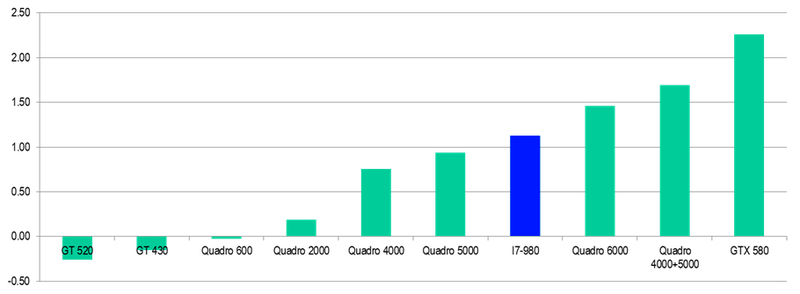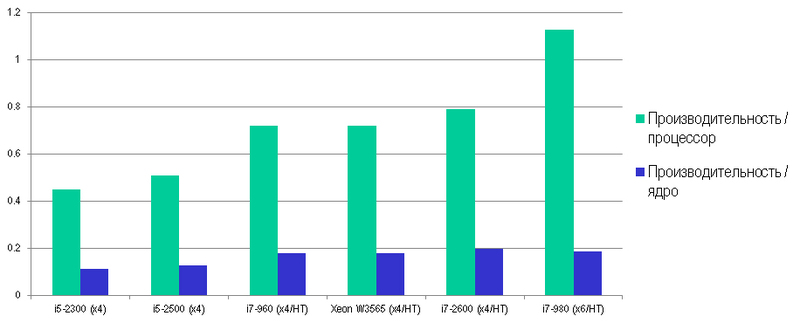V-Ray and Iray. Comparison and review
Rendering speed or quality of the result? - that is the question. Sooner or later you have to choose the second one, and the rendering duration starts to be hours, days, weeks. There is no money for a render farm, so you have to manage with one 6-core processor.
But suddenly, the company Mental Images, a subsidiary of NVIDIA Corporation, releases a new rendering system Iray, which will allow rendering on a graphics card. This put the hope that with the help of multi-core GPUs it will be possible to significantly reduce the rendering time.
I decided to compare the quality and performance of V-ray, which uses only the CPU, and Iray, which counts both on the CPU and on the GPU. I started checking on NVIDIA cards with CUDA support and the Intel Core i7-980 processor.
I'll start by comparing the video cards to each other in the Iray environment. In fairness, the graphics show the performance results of video cards without taking into account the performance of the CPU.

From the diagram it follows that the younger Quadro (and even more so the younger GeForce) are absolutely not adapted for the design tasks. Moreover, the performance of the Quadro 600 was even negative, i.e. the processor coped with the task alone faster than paired with the Quadro 600. On the contrary, the uncut, full-featured GF110 chip in the GeForce GTX 580 showed tremendous results, ahead of two Quadro 4000 and 5000 working in pairs.
With the rendering speed, everything is clear - in the Iray 2xGTX 580 system they give a 4-fold increase in performance in comparison with the i7-980, at the same cost. What about quality? What quality of rendering can the Iray system produce in comparison with V-ray.

The illustrations show the result of Iray rendering using the material “metal” and a relief map (25 minutes) and the result of rendering V-ray using a mirror material and a reflection map (2 minutes). And this is all despite the fact that Iray rendered both on the video card and on the central processor.
Another example is a monochrome model with one light source.

The examples show that acceptable image quality in V-ray is achieved already with a 9-second rendering. The quality of the Iray continues to "limp" and with a longer miscalculation.
An interesting feature of the Iray system is that there are no settings as such that allow you to change the quality. The user is given the opportunity to set the time that he wants to spend on rendering. A miscalculation of the entire image is carried out without stopping - improving the image quality over and over again.
The disadvantage of Iray, for me personally, is that it is practically incompatible with Mental ray. I did not manage to transfer mentalal materials to ayrei - I had to texture everything all over again.
And finally, I would like to suggest a CPU performance comparison table when rendering V-Ray.

Due to the fact that rendering supports multichannel, processor performance depends more on the number of cores than on the frequency characteristics. However, the performance of the kernel separately is higher with the Sandy Bridge i7-2600 processor.
The conclusion I made for myself: rendering is a very complicated computational process and, so far, it is too hard for a graphics processor. A render farm from multi-core CPUs is the only salvation today.
But suddenly, the company Mental Images, a subsidiary of NVIDIA Corporation, releases a new rendering system Iray, which will allow rendering on a graphics card. This put the hope that with the help of multi-core GPUs it will be possible to significantly reduce the rendering time.
I decided to compare the quality and performance of V-ray, which uses only the CPU, and Iray, which counts both on the CPU and on the GPU. I started checking on NVIDIA cards with CUDA support and the Intel Core i7-980 processor.
I'll start by comparing the video cards to each other in the Iray environment. In fairness, the graphics show the performance results of video cards without taking into account the performance of the CPU.

From the diagram it follows that the younger Quadro (and even more so the younger GeForce) are absolutely not adapted for the design tasks. Moreover, the performance of the Quadro 600 was even negative, i.e. the processor coped with the task alone faster than paired with the Quadro 600. On the contrary, the uncut, full-featured GF110 chip in the GeForce GTX 580 showed tremendous results, ahead of two Quadro 4000 and 5000 working in pairs.
With the rendering speed, everything is clear - in the Iray 2xGTX 580 system they give a 4-fold increase in performance in comparison with the i7-980, at the same cost. What about quality? What quality of rendering can the Iray system produce in comparison with V-ray.

The illustrations show the result of Iray rendering using the material “metal” and a relief map (25 minutes) and the result of rendering V-ray using a mirror material and a reflection map (2 minutes). And this is all despite the fact that Iray rendered both on the video card and on the central processor.
Another example is a monochrome model with one light source.

The examples show that acceptable image quality in V-ray is achieved already with a 9-second rendering. The quality of the Iray continues to "limp" and with a longer miscalculation.
An interesting feature of the Iray system is that there are no settings as such that allow you to change the quality. The user is given the opportunity to set the time that he wants to spend on rendering. A miscalculation of the entire image is carried out without stopping - improving the image quality over and over again.
The disadvantage of Iray, for me personally, is that it is practically incompatible with Mental ray. I did not manage to transfer mentalal materials to ayrei - I had to texture everything all over again.
And finally, I would like to suggest a CPU performance comparison table when rendering V-Ray.

Due to the fact that rendering supports multichannel, processor performance depends more on the number of cores than on the frequency characteristics. However, the performance of the kernel separately is higher with the Sandy Bridge i7-2600 processor.
The conclusion I made for myself: rendering is a very complicated computational process and, so far, it is too hard for a graphics processor. A render farm from multi-core CPUs is the only salvation today.
')
Source: https://habr.com/ru/post/130378/
All Articles